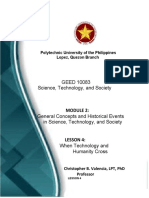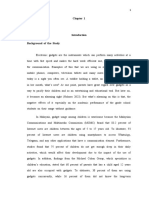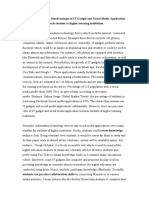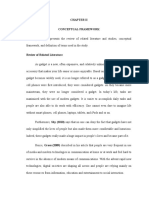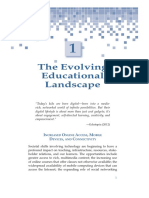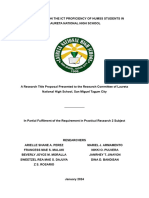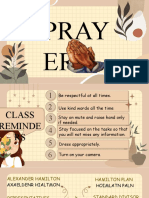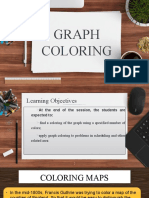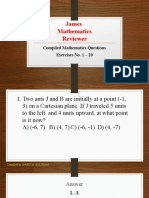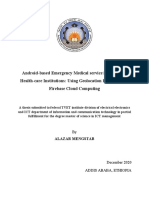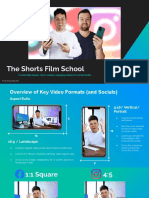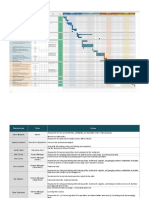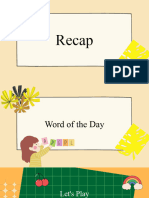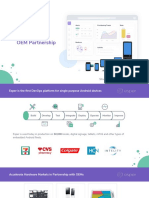DIGITAL CONSUMPTION OF JUNIOR AND SENIOR HIGH
SCHOOL LEARNERS: ITS USE FOR ACADEMIC
AND NON-ACADEMIC ACTIVITIES
Ronah Delle V. Lingaton
Mark Bryan S. Campuso
Jeralvin F. Buyan
Ciaren V. Gamalo
Isabel A. Buyan
March 2023
� Chapter 1
THE PROBLEM AND ITS SCOPE
Rationale
Digital consumption refers to the use of digital
technology, including devices and online platforms, to
access and consume digital content such as videos, music,
games, and social media. It includes activities such as
browsing the internet, watching videos, playing games,
sending and receiving messages, and sharing content on
social media platforms (Nielsen, 2016). With the rapid rate
of screen time on youths now, it’s vital to have optimal
lead, higher social impact, and more responsible in their
digital lives.
Hootsuite Global Survey in 2021 showed that across the
7.83 billion population in the world, 59.5% of them are
internet users aged 16 to 64 and spend an average daily time
to 6 hours using the internet on all media and devices.
However, the survey also showed that the Philippines is at
the top of the list of daily time spent using the internet
on any device, with nearly 11 hours spent each day.
Moreover, high school students today have grown up in a
digital age and are among the most active users of digital
technology. According to the Philippine Daily Inquirer (PDI)
1
�report in 2021, they found out that 79% of enrolled school-
age Filipino students had a smartphone, about 13% got a
desktop or laptop, 5% bought a television, and 3% earned a
tablet. It divulges that high school students today use
digital technology in various ways, both for academic and
non-academic activities.
Furthermore, in several fields worldwide, Information
and Communication Technology (ICT), has been an integral
part of the teaching and learning process for high school
students (Amponsah, 2022). Digital devices and apps are used
to access educational resources and learning purposes. Also,
social media too is a popular activity among high school
students; as reported by the Philippine Statistics Authority
(PSA) in 2019, Filipino students 10 to 30 years old used the
internet more frequently for social media (86.8%) than for
research work and e-mail (81.4%). This was observed in urban
and rural areas, between sexes, and among age groups.
Given the scenarios mentioned above, the researchers
planned the following goals: asses the digital consumption
of Junior and Senior High students of Bugsoc High School in
the SY 2022-2023. Furthermore, it seeks to identify the
average daily use of these students in their technology
devices in terms of their usefulness for academic and non-
2
�academic purposes, whether in the use of the internet or
offline.
Literature Background
There is something addictive and enthralling about the
world where everything is digital. Billions of people
throughout the length of the day are continuously engrossed
in the consumption of the internet, social media, mobile
applications, and other digital communication technologies.
Digital consumption can be defined as the use of digital
technology to access and consume content, products, and
services via the internet and other digital channels (Lee &
Ma, 2012). This concept is particularly relevant in today’s
society, where more and more people are relying on digital
devices to fulfill their needs and desires.
There are a wide variety of gadgets that are commonly
used for digital consumption, including smartphones,
tablets, laptops, desktop computers, smartwatches, and smart
TVs (Kim & Ko, 2021). Digital consumption involves a range
of activities, such as watching videos, listening to music,
browsing social media, shopping online, playing games, and
accessing news and information (Hargittai, 2019).
According to Data Reportal 2023, rapid growth in mobile
use is also helping to fuel the increasing digital adoption
3
�and activity. Their latest data reveal that more than two-
thirds of the world’s total population now uses a mobile
phone, reaching 5.44 billion in January 2023. The number of
cellular connections associated with smartphones continues
to increase, and the latest figures indicate that
smartphones now account for roughly 4 in 5 of the mobile
phones in use around the world today. A total of 5.16
billion people around the world use the internet at the
start of 2023, which is equivalent to 64.4 percent of the
world’s total population. Internet users continue to grow
too, with the latest data indicating that the world’s
connected population grew by close to 100 million users in
the 12 months to January 2023. At just under 2 percent, this
year-on-year growth rate is quite a bit slower than the
growth rates we saw during the middle of the last decade.
Data from Global System for Mobile Communications
Association (GSMA) Intelligence shows that there were 168.3
million cellular mobile connections in the Philippines at
the start of 2023. However, note that many people around the
world make use of more than one mobile connection – for
example, they might have one connection for personal use,
and another one for work – so it’s not unusual for mobile
connection figures to significantly exceed figures for the
total population. GSMA Intelligence’s numbers indicate that
4
�mobile connections in the Philippines were equivalent
to 144.5 percent of the total population in January 2023. It
is also indicated that there were 85.16 million internet
users in the Philippines at the start of 2023 when internet
penetration stood at 73.1 percent and the most commonly used
apps are Facebook, YouTube, Instagram, TikTok, LinkedIn,
Snapchat, and Twitter. Moreover, according to the Philippine
National Youth Commission (2020), students are the most
frequent digital users in the country.
Digital media online has become an important tool for
students and can offer several benefits for their learning
experiences. One of the most significant benefits of digital
media is the accessibility and flexibility it offers,
allowing students to access learning materials and
participate in classes from anywhere, at any time (Al-
Busaidi, 2020). Digital media can also provide engaging and
interactive learning experiences, through the use of
multimedia resources such as videos, simulations, and games.
These can be particularly effective in helping students to
visualize complex concepts and ideas (Minocha, 2012).
Additionally, digital media can support collaborative
learning and knowledge-sharing, through the use of online
discussion forums, social media platforms, and other online
tools (Rogers & Johnson, 2017). Overall, digital media
5
�online can offer several benefits to students, including
increased access and flexibility, engaging and interactive
learning experiences, and support for collaborative learning
and knowledge-sharing.
Meanwhile, digital media offline, such as electronic
books, mobile apps, and other digital tools can also be
beneficial to students. One of the main benefits of digital
media offline is that it allows students to access
educational materials and resources even when they do not
have internet connectivity (Huang, et.al, 2017). This is
particularly important in areas where connectivity is
limited or unreliable, as it can ensure that students have
access to educational resources and materials at all times.
Digital media offline can also provide students with
opportunities for self-directed learning and exploration,
through the use of educational apps, simulations, and other
interactive tools (Wu et.al, 2017). Overall, digital media
offline can provide several significant benefits to
students, including increased access to educational
resources, and support for personalized learning and
exploration.
While digital media can offer many benefits to
students, it can also present several challenges and issues
that can affect their well-being and learning experiences.
6
�One of the primary concerns related to digital consumption
among students is the potential for addiction and overuse.
Excessive use of digital media has been linked to negative
impacts on mental health, including anxiety, depression, and
poor sleep quality (Liu et al., 2021). Another issue related
to digital consumption is the potential for distraction and
reduces attention spans. Frequent use of digital media can
lead to a lack of focus and reduced ability to concentrate
on academic tasks, which can affect learning outcomes (Rosen
et.al, 2013). A related issue is the potential for social
isolation and reduced face-to-face interaction. Increased
use of digital media has been linked to reduced social
engagement and decreased opportunities for in-person
communication and interaction, which can affect social and
emotional well-being (Twenge & Camphell, 2019). Overall,
while digital consumption can offer to students, it is
important to be aware of the potential issues and challenges
that it can present, and to take steps to mitigate these
risks.
7
� Data gathered from the
respondents in Grade 9
and Grade 10 Junior
High School students
and Senior High School
students
Profile of the
respondents:
*Age;
*Gender;
*Grade Level;
*Gadgets Used
Digital Consumption for Digital Consumption for
Academic Activities Non-Academic Activities
Digital Consumption of Junior
and Senior High School Learners:
Its Use for Academic and Non-
Academic Activities
Figure 1. Conceptual Framework
8
� THE PROBLEM
Statement of the Problem
This study aims to explore the digital consumption of
the Junior and Senior High School students of Bugsoc High
School for the Academic Year 2022-2023 in terms of their
usage for Academic and Non-Academic activities.
Specifically, it aims to answer the following sub-
questions:
1. What is the profile of the respondents in terms of:
1.1 Age;
1.2 Gender;
1.3 Grade level; and
1.4 Gadgets used?
2. What is the digital consumption profile of the
respondents in the aspect of:
2.1 Platforms used;
2.2 Hours spent for Academic activities;
2.3 Hours spent for Non-Academic activities;
2.4 Perceived use for Academic activities; and
2.5 Perceived use for Non-Academic activities?
9
� 3. Is there a significant difference between the digital
consumption of male and female students in terms of:
3.1 Use for Academic activities; and
3.2 Use for Non-Academic activities?
4. Is there a significant difference between the digital
consumption use of the students to Academic activities
and Non-Academic activities?
Null Hypotheses
1. There is no significant difference between the
digital consumption of male and female students in
terms of use for Academic and Non-Academic
activities.
2. There is no significant difference between the
digital consumption use of the students to Academic
and Non-Academic activities.
10
�Significance of the Study
This study was conducted to have an understanding and
insights on the Digital Consumption of the Junior and Senior
High School students in terms of their uses in academic and
non-academic activities. This would also provide valuable
information on the students’ current digital activity and
the relevance to their academic and non-academic activities.
The overall information gathered would assess the
respondents if they should respond to the changing landscape
of technology.
Furthermore, this study would benefit the following:
Administration. It provides information on the
students’ digital consumption and give them an idea to come
up with a resolution to reduce the consumption of digital
that can be implemented in such a school.
Students. It will aid in educating them about their
digital consumption in terms of their uses in academic and
non-academic activities. It will as well encourage them to
analyze and critically manipulate their daily digital usage.
Teachers. The data findings in this study will inform
the teachers of the digital consumption of their students in
11
�academic purposes and non-academic purposes and how could
this be useful for their learning in school.
Parents. The study outcomes will help parents on
knowing the digital consumption of their offspring and it
will also beneficial in providing the correct guidance to
their offspring’s digital usage.
Future Researchers. The next person who will also make
a thesis in the near future. This brings an idea to the
future researchers who would conduct studies relating to
this field.
RESEARCH METHODOLOGY
Research Design
This study employed a descriptive design to determine
an adequate understanding and findings on the students’
digital consumption in terms of their uses in academic and
non-academic activities. As defined by McCombes (2019), a
descriptive research design aims to describe a population,
situation, or phenomenon accurately and systematically. It
can answer what, where, when and how questions, but not why
questions. It also employs a wide variety of research
methods to investigate one or more variables.
12
�Environment and Participants
The locale of the study is Bugsoc High School, Sierra
Bullones District, and DepEd-Division of Bohol. One of the
four public secondary schools in the District of Sierra
Bullones, Bohol. It is situated in the rural area, five
kilometers from the Población. It is categorized as a medium
school, with a total number of 454 students.
The research participants are forty (40) junior high
school students: 20 males and 20 females; and forty (40)
senior high school students: 20 males and 20 females, for
the Academic Year 2022-2023. The researchers utilized
complete enumeration since all population members serve as
respondents. These students are taking up General Academic
Strand- one of the core Senior High School Track, and the
major subjects in Junior High School which the use of
digital media is a necessity.
Research Instrument
There are two sources of data in this study ;(1)
collecting the personal data of the respondents including
their digital consumption profile, (2) a survey
questionnaire that contains evaluative questions and the
respondents will check the corresponding level of degree of
13
�indicators on their digital consumption. The questionnaire
is one of the most common instruments for data gathering. It
is intended to contain information about condition or
practices of which the respondents are presumed to have
knowledge.
The questionnaire was divided into two section A and B.
Section A seeks to answer respondent’s personal data such as
age, grade level, gender, and gadgets used. Section B was
the question proper. It included the following factors that
correspond to their digital consumption in online and
offline activities for academic and non-academic purposes.
The three factors are student’s daily average digital usage
online for academic purposes, length of daily exposure to
digital usage online for non-academic purposes and lastly,
how addicted they are to their gadgets. The corresponding
levels of degrees were Strongly Disagree, Disagree, Agree
and Strongly Agree. The assessment questionnaire is inspired
by the study of Gomez (2012) and de Guzman, Jr. (2017).
Data Collection Procedure
With due respect to higher authority, asking permission
to the School Principal and advisers will be done to
formally conduct the study. Point out the reasons and key
factors that lead the proponents to address the problem.
14
�Once the consent is granted, the researchers will conduct
the survey. Then, choose respondents who have personal
gadget.
The questionnaires will be distributed to the Grade 9,
10, 11, and 12 students as permitted by their respective
advisers. The results were collated in tables for purposes
of analysis and interpretation and statistically treated to
test the hypotheses.
Statistical Treatment
The gathered data were interpreted and served as bases
in analyzing the results:
1. To obtain the percentage, the formula has been used:
F
P= x 100
N
Where:
P= Percentage
F= Frequency
N= Number of Respondents
2. To obtain the weighted mean, the formula has been used:
FxW
WM=
N
Where:
15
� WM = Weighted Mean
F = Frequency
W = weight
N= Number of Respondents
After computing the weighted mean, the results were then
interpreted using the following scale:
Scale Descriptive Value Interpretation
3.26-4.00 SA Strongly Agree
2.51-3.25 A Agree
1.76-2.50 D Disagree
1.00-1.75 SD Strongly Disagree
3. To determine the difference in the proportion of
students who uses digital tools for academic purposes
and to who uses digital tools for non-academic
purposes, t-test difference between two-means-
independent samples was used.
16
� DEFINITION OF TERMS
The following operational terms were defined to
facilitate understanding and interpretation to clarify the
content of this study:
Digital Consumption. Refer to the use of digital
technology such as smartphones, computers, and internet, for
various activities such as communication, entertainment,
shopping, and information gathering.
Online. Refer to the state of being connected to the
internet or being accessible through the internet.
Digital Consumption in Online Activities for Academic.
Refer to the students that uses internet that able to access
a vast amount of information and resources online for their
academic purposes.
Digital Consumption in Online Activities for Non-
Academic. Refer to the students that uses internet that are
not about for their studies but for entertainment only.
Offline. Refer to the activities that are not available
or accessible through the internet or not relying to the
internet for access.
17
� Digital Consumption in Offline Activities for Academic.
Refer to the integration of digital tools and devices into
digital academic practices and settings without the use of
internet.
Respondents. Refer to the Junior and Senior High School
students in Bugsoc High School in Academic Year 2022-2023
who use gadgets for academic learning and non-academic
learning.
Survey Questionnaire. A list of items that needs to be
verified or check. It allows you to critic on outcome based
on standards given.
18
� RESEARCH INSTRUMENT
QUESTIONNAIRE
Direction: Please answer the questionnaire by selecting or
putting check to your most accurate response to each
question. Please be serious in answering and if possible
don’t leave a question unanswered. Your answer will be
treated with the utmost confidentiality.
PART I: Personal Data
Name: ____________________________ Age: _______
Sex: ____ Male ____ Female
Grade Level: ____________
Gadgets Used: ______ Laptop _______ Computer
______ Mobile Phone _______ Tablet
______ Others
19
�PART II: Digital Consumption Profile
Direction: Please put a (✔) on the blank.
1. What platforms you usually used, Are you on....
❖ Online Academic Tools
Google ___________
YouTube ___________
Photomath ___________
Brainly ___________
Adobe Creative ___________
Canva ___________
EdX ___________
Grammarly ___________
Quora ___________
Pinterest ___________
Others __________
❖ Offline Academic Tools
20
�Merriam-Webster Dictionary ___________
Filipino-English Dictionary ___________
Filipino-English Translator ___________
Scientific Calculator ____________
Kinemaster ____________
WPS Office ____________
Wordscapes ____________
4PICS 1Word ____________
EReader Prestigio ____________
Others ____________
❖ Online Non-Academic Tools
Facebook ____________
Instagram ____________
Tiktok ____________
Spotify ____________
Shopee ____________
Lazada ____________
Mobile Legends: Bang Bang ____________
Viu: Korean & Asian Content ____________
Bilibili ____________
21
� IQIYI-Drama, Anime ____________
OmeTv ____________
Wattpad ____________
PUBG
(PlayerUnknown’s Battlegrounds- Mobile Game) ____________
COC (Clash of Clans- Mobile Game) ____________
Netflix ____________
Others ____________
2. How many hours do you spend on these platforms for
Academic purposes in a day?
Less than 1 Hour ____________
1-2 Hours ____________
2-3 Hours ____________
3-4 Hours ____________
More than 4 Hours ____________
3. How much hours do you spend on these platforms for Non-
Academic Activities in a day?
Less than 1 Hour ____________
1-2 Hours ____________
22
�2-3 Hours ____________
3-4 Hours ____________
More than 4 Hours ____________ v
Table 1. Perceived Digital Consumption in terms of
Academic Activities in Online Use
Strongly Agree Disagree Strongly
Indicators Agree Disagree
(4) (3) (2) (1)
1. I do homework on
my phone or any
gadget I have.
2. I search the
internet for
information for
schoolwork.
3. I participate on
online communities
or forums related
to the subject I
want to learn
(Messenger,
Facebook, etc.)
4. I use online tools
(Messenger,
Facebook, etc.) to
contact other
students about
schoolwork or
group projects.
5. I use online tools
(Messenger,
Facebook, etc.) to
find out what has
been covered in
class during non-
attendance.
6. I use online tools
(Messenger,
Facebook, etc.) to
exchange lecture
notes.
7. I use these online
tools (Facebook,
Messenger) to find
23
� out about
activities
organized by my
school.
8. I use these online
tools to find
out informational
articles that
could improve my
studies.
9. I use these online
tools to contract
or consult my
teachers on the
topic of study.
10. I use these
online tools for
tutorials to
improve creativity
and skills.
Table 2. Perceived Digital Consumption in terms of
Academic Activities in Offline Use
Strongly Agree Disagree Strongly
Indicators Agree Disagree
(4) (3) (2) (1)
1. I use my app
dictionary to find
meaning to
unfamiliar words.
2. I use my app
dictionary to
learn and
understand
complicated words.
3. I use my app
translator to
translate words
and phrases
handily.
4. I use my app
calculator to
easily calculate
math problems.
24
�5. I use my app video
editor to edit my
video projects.
6. I use my WPS
Office app to view
files and
documents.
7. I use my WPS
Office app to
encode and make
documents.
8. I use my WPS
Office app to note
important
documents for
school.
9. I use my Wordscape
app to know more
words and broaden
my vocabulary.
10. I use my 4Pics
1Word app as my
brain teaser game.
Table 3.Percieved Digital Consumption in terms of Non-
Academic Activities
Strongly Agree Disagree Strongly
Indicators Agree Disagree
(4) (3) (2) (1)
1. I use my cellphone
or gadget to
communicate my
friends.
2. I use my phone as
a free time
activity.
3. I fell happy
whenever I use to
browse in my
phone.
4. I use my phone to
watch my favorite
movies for leisure
time.
5. I use my phone to
enjoy music
anytime.
25
� 6. I use online tools
to make friends.
7. I use online tools
to find out about
current affairs,
or issues.
8. I use online tools
apps for games to
make me happy.
9. I use online tools
to look for a
partner or date.
10. I cannot live
without using my
phone in a day.
Thank you for sharing your thoughts with us. We are grateful
for sharing your time and effort. Have a great day!
-Researchers
26








